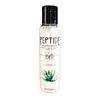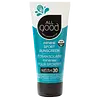What's inside
What's inside
 Key Ingredients
Key Ingredients

 Benefits
Benefits

 Concerns
Concerns

 Ingredients Side-by-side
Ingredients Side-by-side

Titanium Dioxide 5%
Cosmetic ColorantZinc Oxide 5%
Cosmetic ColorantAloe Barbadensis Leaf Juice
Skin ConditioningAloe Barbadensis Leaf
MaskingGlycerin
HumectantCucumis Sativus Fruit Extract
EmollientPassiflora Caerulea Flower Extract
Skin ConditioningPalmitoyl Oligopeptide
CleansingN-Hydroxysuccinimide
Skin ConditioningPalmitoyl Tetrapeptide-7
Skin ConditioningPalmitoyl Pentapeptide-5
Skin ConditioningPersea Gratissima Oil
Skin ConditioningSimmondsia Chinensis Seed Oil
EmollientVitis Vinifera Seed Oil
EmollientCaprylic/Capric Triglyceride
MaskingButyrospermum Parkii Butter
Skin ConditioningStearic Acid
CleansingGlyceryl Stearate
EmollientSilica
AbrasivePPG-5 Tocopheryl Ether
AntioxidantCetyl Alcohol
EmollientMica
Cosmetic ColorantTitanium Dioxide 5%, Zinc Oxide 5%, Aloe Barbadensis Leaf Juice, Aloe Barbadensis Leaf, Glycerin, Cucumis Sativus Fruit Extract, Passiflora Caerulea Flower Extract, Palmitoyl Oligopeptide, N-Hydroxysuccinimide, Palmitoyl Tetrapeptide-7, Palmitoyl Pentapeptide-5, Persea Gratissima Oil, Simmondsia Chinensis Seed Oil, Vitis Vinifera Seed Oil, Caprylic/Capric Triglyceride, Butyrospermum Parkii Butter, Stearic Acid, Glyceryl Stearate, Silica, PPG-5 Tocopheryl Ether, Cetyl Alcohol, Mica
Zinc Oxide 16%
Cosmetic ColorantAloe Barbadensis Leaf Juice
Skin ConditioningArachidyl Alcohol
EmollientArachidyl Glucoside
EmulsifyingBehenyl Alcohol
EmollientBisabolol
MaskingButyloctyl Salicylate
Skin ConditioningButyrospermum Parkii Butter
Skin ConditioningCalendula Officinalis Flower
Skin ConditioningCamellia Sinensis Leaf Extract
AntimicrobialCaprylhydroxamic Acid
Capryloyl Glycerin/Sebacic Acid Copolymer
Skin ConditioningCaprylyl Glycol
EmollientCellulose Gum
Emulsion StabilisingCetearyl Alcohol
EmollientCetyl Alcohol
EmollientCitric Acid
BufferingCoco-Glucoside
CleansingCocos Nucifera Oil
MaskingDiheptyl Succinate
EmollientGlycerin
HumectantHelianthus Annuus Seed Oil
EmollientMauritia Flexuosa Fruit Oil
Skin ConditioningMicrocrystalline Cellulose
AbsorbentOlea Europaea Fruit Oil
MaskingPolyhydroxystearic Acid
EmulsifyingRosa Canina Seed Extract
EmollientRubus Idaeus Seed Oil
EmollientSodium Gluconate
Skin ConditioningSodium Hyaluronate
HumectantSodium Stearoyl Glutamate
CleansingTheobroma Cacao Seed Butter
EmollientTocopherol
AntioxidantWater
Skin ConditioningZinc Oxide 16%, Aloe Barbadensis Leaf Juice, Arachidyl Alcohol, Arachidyl Glucoside, Behenyl Alcohol, Bisabolol, Butyloctyl Salicylate, Butyrospermum Parkii Butter, Calendula Officinalis Flower, Camellia Sinensis Leaf Extract, Caprylhydroxamic Acid, Capryloyl Glycerin/Sebacic Acid Copolymer, Caprylyl Glycol, Cellulose Gum, Cetearyl Alcohol, Cetyl Alcohol, Citric Acid, Coco-Glucoside, Cocos Nucifera Oil, Diheptyl Succinate, Glycerin, Helianthus Annuus Seed Oil, Mauritia Flexuosa Fruit Oil, Microcrystalline Cellulose, Olea Europaea Fruit Oil, Polyhydroxystearic Acid, Rosa Canina Seed Extract, Rubus Idaeus Seed Oil, Sodium Gluconate, Sodium Hyaluronate, Sodium Stearoyl Glutamate, Theobroma Cacao Seed Butter, Tocopherol, Water
Ingredients Explained
These ingredients are found in both products.
Ingredients higher up in an ingredient list are typically present in a larger amount.
Aloe Barbadensis Leaf Juice comes from leaves of the aloe plant. Aloe Barbadensis Leaf Juice is best known for helping to soothe sunburns. It is also anti-inflammatory, moisturizing, antiseptic, and can help heal wounds.
Aloe is packed with good stuff including Vitamins A, C, and E. These vitamins are antioxidants, which help fight free-radicals and the damage they may cause. Free-radicals are molecules that may damage your skin cells, such as pollution.
Aloe Barbadensis Leaf Juice also contains sugars. These sugars come in the form of monosaccharides and polysaccharides, folic acid, and choline. These sugars are able to help bind moisture to skin.
It also contains minerals such as calcium, 12 anthraquinones, fatty acids, amino acids, and Vitamin B12.
Learn more about Aloe Barbadensis Leaf JuiceThis ingredient is also known as shea butter. It is an effective skin hydrator and emollient.
Emollients help soothe and soften your skin. It does this by creating a protective film on your skin. This barrier helps trap moisture and keeps your skin hydrated. Emollients may be effective at treating dry or itchy skin.
Shea butter is rich in antioxidants. Antioxidants help fight free-radicals, or molecules that may harm the body. It is also full of fatty acids including stearic acid and linoleic acid. These acids help replenish the skin and keep skin moisturized.
While Shea Butter has an SPF rating of about 3-4, it is not a sunscreen replacement.
Shea butter may not be fungal acne safe. We recommend speaking with a professional if you have any concerns.
Learn more about Butyrospermum Parkii ButterCetyl Alcohol is a fatty alcohol. Fatty Alcohols are most often used as an emollient or to thicken a product.
Its main roles are:
Though it has "alcohol" in the name, it is not related to denatured alcohol or ethyl alcohol.
The FDA allows products labeled "alcohol-free" to have fatty alcohols.
Learn more about Cetyl AlcoholGlycerin is already naturally found in your skin. It helps moisturize and protect your skin.
A study from 2016 found glycerin to be more effective as a humectant than AHAs and hyaluronic acid.
As a humectant, it helps the skin stay hydrated by pulling moisture to your skin. The low molecular weight of glycerin allows it to pull moisture into the deeper layers of your skin.
Hydrated skin improves your skin barrier; Your skin barrier helps protect against irritants and bacteria.
Glycerin has also been found to have antimicrobial and antiviral properties. Due to these properties, glycerin is often used in wound and burn treatments.
In cosmetics, glycerin is usually derived from plants such as soybean or palm. However, it can also be sourced from animals, such as tallow or animal fat.
This ingredient is organic, colorless, odorless, and non-toxic.
Glycerin is the name for this ingredient in American English. British English uses Glycerol/Glycerine.
Learn more about GlycerinZinc Oxide is a mineral broad-spectrum UV filter; it is the broadest UVA and UVB reflector approved by the FDA. It also has skin protectant and skin soothing properties.
Zinc oxide is one of the most effective broad-spectrum UV filters. It protects against UVB, UVAII, and UVAI. In comparison to its counterpart titanium dioxide, zinc oxide provides uniform and extended UVA protection.
Another great benefit? This ingredient is highly photostable so it won't degrade easily under sunlight.
A common myth is that mineral UV filters are widely believed to primarily reflect UV light.
However, modern research shows titanium dioxide absorbs UV radiation like chemical filters (~95% absorption & 5% reflection).
Zinc oxide has great skin soothing properties so you'll likely find this in sunscreens formulated for sensitive skin or babies/children. It is unlikely to cause "eye sting" like other sunscreen ingredients.
Regulatory agencies consider zinc oxide to be non-toxic and safe. It has also been shown to not penetrate the skin.
Unfortunately, this ingredient does leave a visible white cast. This is why mineral sunscreens are often less cosmetically elegant than chemical or hybrid ones.
In cosmetics, zinc oxide can be found in both non-nano and nano-sized forms. The nano version is used to reduce white cast and improve the texture of sunscreen formulas.
There are ongoing concerns surrounding nano-zinc oxide's impact on marine ecosystems and whether it can be absorbed into skin.
Regarding marine ecosystems and coral reefs, there is no conclusive evidence that any form of zinc oxide (or any other sunscreen ingredients) will cause harm. The science is still developing but many consumers are keeping a close eye on this issue.
Please note, many destinations have reef-safety sunscreen rules. For instance, the U.S. Virgin Islands advises all visitors to use non-nano mineral sunscreens.
There has also been some stir about whether micronized or nano zinc oxide has potential photoxicity and absorption through the skin/lungs.
An in-vitro (done in a test tube or petri dish) study demonstrated micronized zinc oxide to have potential phototoxicity. There's no need to fret; the EU Commission's Scientific Committee on Consumer Safety has stated, "The relevance of these findings needs to be clarified by appropriate investigations in vivo." Or in other words, further studies done on living organisms are needed to prove this.
Current research shows zinc oxide nanoparticles do not penetrate intact or sunburned skin. They either remain on the surface or in the outermost layer of dead skin (stratum corneum).
Zinc oxide is one of only two classified mineral UV filters with titanium dioxide being the other one.
Fun fact: Zinc has been used throughout history as an ingredient in paint and medicine. An Indian text from 500BC is believed to list zinc oxide as a salve for open wound. The Ancient Greek physician Dioscorides has also mentioned the use of zinc as an ointment in 1AD.
Learn more about Zinc Oxide